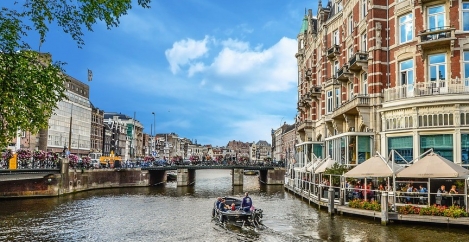December 9, 2019
Two-thirds of major world cities set for weaker growth as global slowdown bites
 A new report from Oxford Economics (registration) predicts that the present slowdown in the global economy will persist into next year and it is already having a significant impact on growth in the world’s major cities and their prospects. Of the top 900 cities around the world, the report predicts that just under two-thirds, some 586, will experience slower growth in the period 2020-21 than they enjoyed during the past five years – in some cases, very markedly slower, with growth rates of some key cities halved or more.
A new report from Oxford Economics (registration) predicts that the present slowdown in the global economy will persist into next year and it is already having a significant impact on growth in the world’s major cities and their prospects. Of the top 900 cities around the world, the report predicts that just under two-thirds, some 586, will experience slower growth in the period 2020-21 than they enjoyed during the past five years – in some cases, very markedly slower, with growth rates of some key cities halved or more.
The effects on cities are felt across regions worldwide. The forecasts suggests that 76 of the top 98 North American cities will see slower GDP growth in 2020-21 than in 2015-19; 156 of the top 232 European cities will do so; and no less than 146 of the 150 mainland Chinese cities, as well as 122 of the 185 non-Chinese Asian cities. In Latin America the figure is 41 of 104 cities, while in the Middle East and Africa it is 45 out of 131 cities.
Marked city slowdowns to hit the US urban growth stars of West Coast and South
- Some of the most marked slowdowns projected for major cities are in the US, which features three of the 10 largest slowdowns projected for the 900 major urban economies. Notably, San Jose, the centre of Silicon Valley, is projected to see its growth rate in 2020-21 more than halve to a projected 3.3 percent, down from the buoyant 7.6 percent average annual pace of expansion over 2015-19. Notable US slowdowns are also forecast in Austin-Round Rock in Texas, where growth is also expected to drop sharply to 2.5 percent in 2020-21 from the 5.7 percent pace in 2015-19, and in San Antonio-New Braunfels, with a slowdown there to 2.3 percent from 5.5 percent.
- While US cities on the West Coast and in the South have generally been setting the pace in recent years, in the next two years the report forecasts that they will out-perform others by much smaller margins versus other US centres than seen in the past.
- Nevertheless, San Francisco is still expected to remain the fastest growing of North America’s 10 largest cities over the 2020-21 period, with projected expansion of 2.4 percent, even if this will be sharply lower than the 5 percent rate from 2015-19. And Dallas is not far behind in 2020-21, with forecast growth of 2.2 percent (down from 3.4 percent in 2015-19).
- New York, of course, remains the biggest city in the US and worldwide, and notably its growth of 1.8 percent in 2020-21 is expected to match the rate seen over the 2015-2019 period. Its West Coast rival, Los Angeles, is expected, by contrast, to see growth slow by 0.9 percentage points over the next two years, to 2 percent, compared with the 2.9 percent rate of the previous five years.
In Europe, Berlin, Munich and Amsterdam to see sharply slower growth ? but London to see modest revival
- In Europe, eastern European cities will continue to set the pace as they have for the last decade or more as lower costs than in Western Europe have attracted inward investment and therefore a partial catch-up in productivity.
- Of the 10 largest European city economies by GDP, we expect the sharpest growth slowdowns in 2020-21 to be in Berlin, where growth is forecast at 1.6 percent, half the rate of the previous five years, and in Amsterdam, with growth also set to halve to 1.5 percent, from 3.1 percent. Notably slower growth is also projected in Madrid (1.9 percent vs 3.2 percent), Munich (1.4 percent vs 2.6 percent), Istanbul (3.5 percent vs 4.6 percent) and Hamburg (1.0 percent vs 1.9 percent).
- London, having seen its growth fall sharply in recent years, should now see a modest improvement in economic performance in the next two years, performing broadly in line with other major cities, where once it easily out-performed.
- The beginning of London’s slowdown coincided with the UK’s decision to leave the EU, and Brexit has clearly created much uncertainty. But there have been other factors at work. London’s productivity growth pre-recession was particularly good compared to the capital cities of France, Spain and Germany, but since then has slowed into line; London’s financial services sector has been struggling for some time; and the business services sector has almost certainly been hit by the global trade slowdown discussed above. The latter has also affected some other European cities mentioned above, such as Hamburg and to some extent, Amsterdam. Among Europe’s largest cities, Paris is also projected to see only a modest slowdown, to 1.5 percent over 2020-21 from 1.8 percent in 2015-19.
China’s slowdown to brake growth in its leading cities after past rapid expansion
- In Asia, the cities growth story of the first decade of this century was dominated by Chinese cities, with the largest four metropolitan areas (Shenzhen, Beijing, Guangzhou and Shanghai) among many that grew by more than 10 percent a year. However, once headlong growth rates in these major centres and in other Chinese cities are now slowing, as China’s economy cools.
- Among the ten largest Asian cities by GDP, the report projects the largest slowdowns in the next two years to come in Chongqing, with growth set to fall to 6.0 percent from 8.7 percent in the prior five years and in Shenzhen, with 6.3 percent growth compared with 7.9 percent. Guangzhou will also slow sharply, to 6.1 percent in 2020-21 from 7.6 percent over 2015-19. Shanghai’s growth is set to slow to 5.9 percent from 6.7 percent, and Beijing’s to 6.1 percent from 6.7 percent.
- In Asia outside of China, India’s cities continue to boom and set the pace for the fastest growing cities in the world, although none yet make the top 10 global cities ranked by GDP. Looking over the next 15 years, the authors expect the outperformance of Asian cities, on aggregate, to continue, such that by 2035, their total GDP will overtake that of European and North American cities combined.
- A large part of this will be down to the growth of Chinese cities, which although slower than in the past, will still be strong enough to mean that their combined GDP will alone overtake that of North American cities by 2035. That said, the authors forecast overall growth in Indian cities to be stronger than their counterparts in China, partly due to stronger population growth. However, the GDP levels of Indian cities are generally much smaller than for Chinese cities, so India’s overall contribution to the Asian city aggregate will still be smaller in absolute terms than its neighbour’s.
Mexico facing sharpest major city slowdowns in Latin America but Brazilian cities to see resurgence
- Problems (largely but not only political) will continue to dog several Latin American cities, with Caracas clearly the major LatAm city in greatest distress. Of the largest 10 Latin American cities by GDP, the biggest slowdown the authors forecast is in Monterrey in Mexico, with growth projected to drop to 1.8 percent from 3 percent. Mexico City is also set to slow sharply, to 1.8 percent in 2020-21 from 2.7 percent in the previous five years. Mexico has been very much affected by changing political relationships with the US, affecting trade, investments and flows of people. These are likely to have had the greatest impacts on cities close to the border, but also Mexico City.
- Some LatAm cities dogged by economic woes are, however, set to see a rebound in light of stabilising conditions in their national economies. Although Caracas is still expected to see GDP falling by 0.7 percent a year, Rio de Janeiro is forecast to achieve average growth of 1.6 percent in 2020-21, against the average rate of just 0.7 percent in the previous five years, and Sao Paulo is projected to grow by 1.5 percent after a contraction averaging 1.7 percent a year in 2015-19.
Largest urban economies in 2035: six cities retain top-10 ranking, but Chinese giants displace US, Japanese rivals
- The analysis also looks out to 2035 and what the authors project will be the largest cities in the world by that year. We forecast that of the 10 largest cities in the world today, six will still be in the top 10 by GDP in 2035. The top four of New York, Tokyo, Los Angeles, and London, will all retain their places. The new entrants will be four Chinese cities, all of which are currently in the top 20; Shanghai, Beijing, Guangzhou and Shenzhen. Those that will slip out of the top 10 by 2035 will be Osaka, San Francisco, Dallas and Washington—although all will stay within the top 16.














